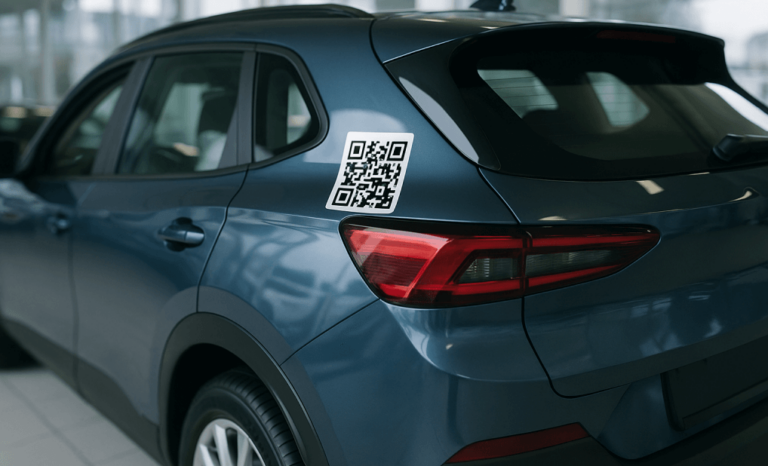What are QR codes doing in the automotive industry?
From dealerships to dashboards, QR codes in automotive industry are quietly but powerfully reshaping how customers interact with vehicles. Whether it’s helping a buyer access specs with a quick scan or simplifying inventory management across thousands of parts, these compact codes are driving serious innovation.
At their core, QR codes—short for “Quick Response” codes—offer a hassle-free way to connect printed matter with digital content. Thanks to dynamic QR code technology, the experience isn’t static. A single scan can unlock detailed information, videos, service history, or even exclusive content, without requiring a new print every time something changes.
Why are car dealerships placing QR codes on vehicles?
Car dealerships are using QR code stickers to simplify the research and buying process for potential buyers. Instead of flipping through brochures or waiting for a salesperson, customers can scan the QR code directly on the car’s windshield to get instant access to model specs, financing options, or even AR-powered virtual tours.
This self-service approach helps dealerships:
- Connect customers to landing pages without friction
- Generate leads even after hours
- Support sales staff with updated digital content
- Enhance the customer experience with immediate access to what they care about most
Dynamic QR codes allow them to update the linked content as needed, meaning one QR code on a vehicle can serve different purposes throughout its sales lifecycle.
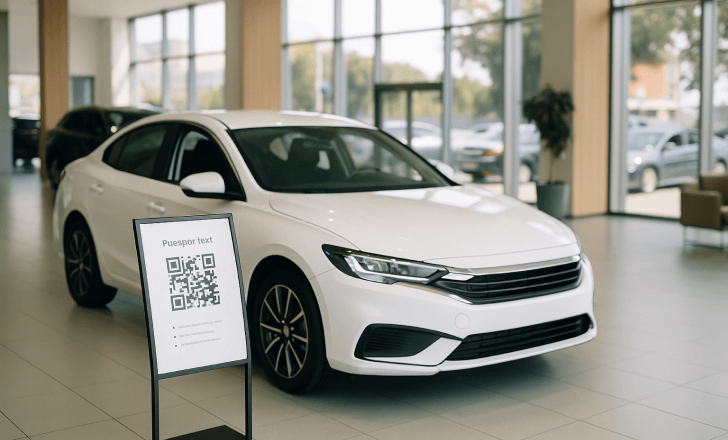
How do QR codes improve the car buying process?
For many customers, buying a car can feel overwhelming—too many options, too much technical jargon, and not enough personalized information. QR code use offers a faster, more intuitive way to cut through the noise.
With one quick scan:
- A first-time buyer can access side-by-side comparisons
- Returning customers can view loyalty offers
- Car enthusiasts can watch videos of the car in action
- All visitors can skip lengthy explanations and explore on their own
This digital layer bridges the information gap without pressure, boosting both trust and engagement.
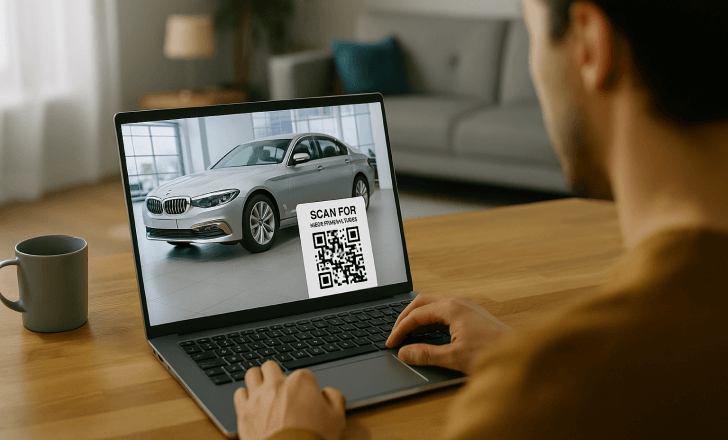
What makes dynamic QR codes ideal for automotive marketing?
Static QR codes have one major limitation—they’re fixed. Once you print them, you can’t change where they lead. That’s a problem in the fast-moving automotive industry, where marketing efforts need to be flexible, timely, and responsive to shifting inventory, seasonal offers, and changing consumer interests. Dynamic QR codes solve that issue with powerful adaptability.
With a dynamic QR code, car dealerships and auto brands can modify the destination URL even after the code is placed on marketing materials or vehicles. Whether you’re using a QR code on a showroom sticker, a printed brochure, or signage outside the dealership, you can instantly update the linked landing page without needing to print a new code. This is especially useful for campaigns targeting car buyers at different stages of the sales process—what starts as a test drive booking page could later become a financing offer or a trade-in calculator.
Dynamic QR codes also support UTM tracking and analytics, helping marketing teams understand scan behavior, device types, time of engagement, and customer location. These insights are invaluable when trying to generate leads or improve customer engagement. Brands can run A/B tests by tweaking offers and measuring which QR code version results in more conversions or longer page visits. They can also update the QR code system regularly based on real-time inventory changes, ensuring the right car models are always being promoted.
This level of control transforms a basic QR code into a versatile marketing tool that aligns with brand identity, provides customers with quick access to exclusive content, and supports a seamless experience across devices. In an industry where timing, data, and presentation matter, using dynamic QR codes gives automotive marketers a major edge.
How are car brands using QR codes to reinforce their identity?
Brand identity is more than a logo—it’s how your product communicates across every touchpoint. Using QR codes creatively lets carmakers maintain consistency while inviting interaction. For example:
- A QR code sticker on the vehicle’s rear window can link to a brand story video
- QR codes in printed marketing materials can lead to immersive AR configurators
- QR codes on the packaging of branded merchandise can unlock loyalty perks
This blend of function and storytelling gives QR code marketing efforts a unique edge.
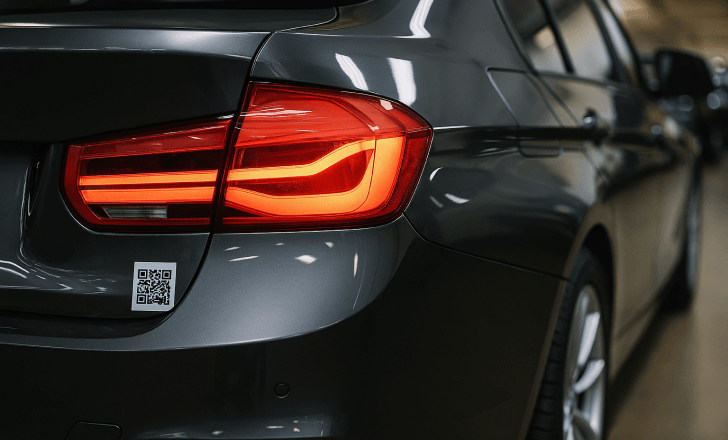
Can QR codes connect buyers to test drives and service appointments?
Yes, and in fact, this is one of the most effective ways QR code technology is streamlining operations across the automotive industry. By placing QR codes at strategic points—on vehicle dashboards, dealership signage, service desks, or even in printed marketing materials—auto brands are giving customers immediate access to essential services with a quick scan.
For instance, potential car buyers visiting a showroom can scan a QR code on the vehicle to instantly book a test drive, eliminating the need to wait for a salesperson or fill out paperwork. After a sale, that same customer might use a car QR code to schedule their next service appointment or receive reminders about routine maintenance. In waiting areas, QR code stickers can direct customers to browse accessories, explore loyalty programs, or provide feedback, all without downloading an app or navigating a complex website.
This QR code system enhances the entire sales and service journey by providing customers with hassle-free, mobile-first experiences. Instead of lengthy explanations or crowded service counters, buyers and owners enjoy quick access to personalized, self-service options. For dealerships, it means faster conversions, improved customer engagement, and fewer missed opportunities—all made possible by simply incorporating QR codes into high-touch points across the customer journey.

How are QR codes used for automotive parts and inventory?
QR codes are also revolutionizing the backend of the automotive industry. Tracking thousands of automobile parts manually is error-prone and inefficient. QR code systems make inventory management smarter.
Manufacturers and suppliers use them to:
- Tag individual automotive parts with detailed data
- Track parts as they move through the supply chain
- Reduce errors in part identification
- Ensure real-time updates to parts databases
For example, placing QR codes on engine components allows a technician to quickly scan and access repair history, compatibility, or safety data.
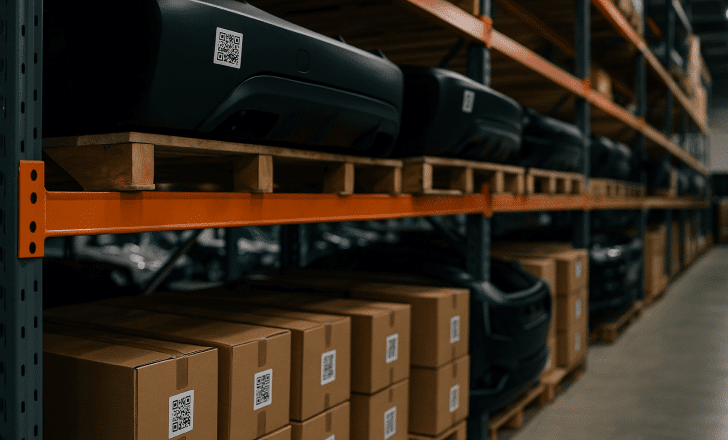
What role do QR codes play in passenger safety?
Passenger safety is becoming an unexpected but important area where QR codes are making an impact in the automotive industry. Although often associated with marketing materials or digital experiences, QR codes are increasingly being used inside vehicles to support safety protocols and emergency response. When a crash or serious incident occurs, a strategically placed QR code on the dashboard, visor, or door frame allows first responders to quickly scan and access vital information about the vehicle, including its fuel type, structural layout, and any embedded safety systems. Some codes even link to manufacturer rescue sheets or emergency instructions tailored to the exact model, which can make all the difference in time-critical situations.
In some cases, QR codes can also be configured to share a driver’s emergency contact details or medical information securely—especially important in fleet or commercial vehicles. Automotive brands in Europe and Asia have already begun integrating this type of safety-focused QR code as part of their standard compliance checklist, especially for electric vehicles and complex automobile parts. It’s a small addition with a big impact, providing instant access to required data that could otherwise take minutes to communicate. By using QR codes in this way, manufacturers are enhancing passenger safety and streamlining the flow of essential information when it matters most.

Are QR codes helping with electric vehicles and new technologies?
As EVs and smart vehicles become more common, QR codes are perfectly positioned to support the shift.
For electric models, QR codes can:
- Link drivers to charging station maps
- Provide setup instructions for mobile apps
- Connect to digital manuals and warranty registration
- Deliver over-the-air software update notifications
Because dynamic QR codes can evolve alongside software updates and new features, they’re a natural fit for tech-forward vehicles.
How do QR codes contribute to loyalty programs and after-sales service?
QR codes can play a central role in keeping the relationship alive after the sale. Many brands are embedding QR codes in:
- Loyalty program brochures
- Warranty cards
- Maintenance reminder emails
- Keychains or glove compartment cards
When scanned, they can trigger a personalized message, special discount, or appointment scheduler—making the after-sales journey more engaging and hassle free.
What’s the history of QR code technology in the auto world?
QR codes were invented by Denso Wave Incorporated in 1994—ironically, within the automotive sector. Originally designed to track vehicle parts more efficiently on the assembly line, the technology has now come full circle.
Today, QR codes are used not just for logistics, but also for sales, marketing, customer engagement, and product support—proof that a smart scan can go a long way.
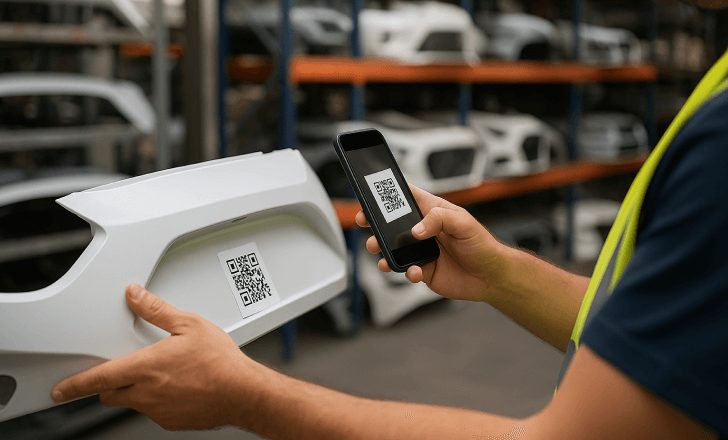
Should your dealership or auto brand start using QR codes?
If you haven’t already, it’s time to reconsider. Using QR codes in the automotive industry isn’t a gimmick—it’s a proven way to:
- Generate leads
- Connect customers to rich content
- Streamline the sales process
- Differentiate your brand
And with tools like QR Code KIT, it’s easier than ever to create, manage, and update your codes without needing a developer.

How do you choose the right QR code generator?
Choosing the right QR code generator is a critical step for anyone in the automotive industry looking to scale their marketing efforts or streamline internal processes. A quality platform should offer dynamic QR code functionality so you can update destinations without reprinting codes—vital for campaigns tied to inventory or changing promotions. Equally important is the ability to customize the appearance of each QR code to reflect your brand identity, ensuring consistency across all customer-facing touchpoints. Look for a solution that includes scan analytics and detailed reporting, so you can track user engagement, understand how potential customers interact with your codes, and fine-tune future strategies accordingly. Seamless integration with your landing page systems, CRM, or dealership software will save time and reduce manual work. A trusted platform like QR Code KIT combines all of these features in one place, helping you manage QR code use across departments and campaigns while maintaining security, scalability, and ease of use.
How can auto brands measure QR code performance?
It’s not enough to put a QR code on a car and hope it works. With the right tools, you can track:
- Number of scans by location or time
- Type of device used
- Engagement rates with linked content
- Conversion paths from scan to sale
These insights turn every scan into a data point that can guide future decisions and improve the customer journey.

Are there any limitations or mistakes to avoid?
Yes—despite their simplicity, QR codes can backfire if not used thoughtfully. Common mistakes include:
- Linking to pages that aren’t mobile-friendly
- Using low contrast or poor sizing (making them hard to scan)
- Not providing any context or call to action
- Choosing static QR codes when updates are required
To ensure success, always test your QR codes across devices and think through the user experience from scan to final destination.
What’s next for QR codes in the automotive industry?
QR codes in the automotive industry are far from reaching their full potential. As both marketing and manufacturing processes become more connected and data-driven, new QR code formats are being developed to keep pace. These upgraded codes feature enhanced error correction, greater data capacity, and faster scanning performance, allowing automotive brands to embed multiple layers of content—such as service history, part specifications, or promotional material—into a single, compact symbol. This evolution means that QR codes will increasingly replace traditional printed matter like brochures, manuals, and spec sheets, offering quicker access to required data with a single scan. The ability to scan QR codes instantly and retrieve rich, up-to-date information will make them a key asset not just for customer engagement, but also for internal operations such as tracking automotive parts and managing inventory. As vehicles get smarter and buyers expect seamless, digital-first experiences, QR code technology will play a vital role in shaping how the automotive industry connects, informs, and sells.

